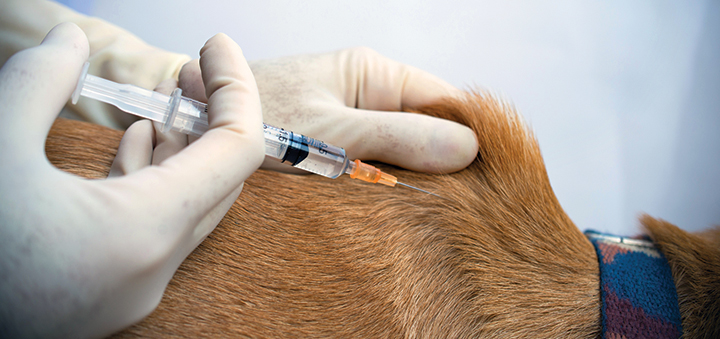Health department offering rabies clinic on March 25
The Chenango County Department of Public Health, Environmental Division, will be holding a free rabies vaccine clinic for cats, dogs, and ferrets from 9 to 10:30 a.m. at the Guilford Highway Department, located at 223 Marble Road in Guilford. Appointments are still available; to register, visit health.ny.gov/go2clinic or call the Chenango County Environmental Health Offices at 607-337-1673. (Sun File Photo)
GUILFORD — The Chenango County Department of Public Health, Environmental Division, is offering a free rabies clinic where Chenango County pet owners can get their dogs, cats, and ferrets vaccinated for rabies.
The clinic will be held on Saturday, March 25 from 9 to 10:30 a.m. at the Guilford Highway Department, located at 223 Marble Road in Guilford.
Vaccinations are completely free, however a $5 donation per animal is suggested, to assist with the cost of offering the clinics.
"They are a free vaccine. The most important thing to us is that more pets get vaccinated. Any donation is appreciated and does help offset the cost associated with putting these events on," said Chenango County Director of Public Health Isaiah Sutton.
Individuals must pre-register their pets in order to receive a vaccination. To register, visit health.ny.gov/go2clinic or call the Chenango County Environmental Health Offices at 607-337-1673.
The day of the clinic, pet owners simply drive through and when it's their turn remove their dog, cat, or ferret from the car to receive their vaccine. Dogs must be kept on a leash, and cats and ferrets should be in a box, crate, pillowcase, or other carrier.
Owners whose pets have already received a rabies vaccine should bring vaccination records to qualify their animal for a three-year certificate. All other pets will need to be re-vaccinated one year after their first rabies vaccine.
Sutton said getting pets vaccinated for rabies is crucial, as an unvaccinated animal who is exposed must be put on a six-month quarantine. In severe cases, euthanizing the animal may be a better option.
"For an unvaccinated animal that is exposed to rabies, we either introduce a strict six-month quarantine. That is in a cage in a locked building, so double confined, for a period of six months where we monitor the health, which is very hard for an animal. Some folks it’s not a possibility. In a small apartment it may be hard to keep your dog in a cage in a bedroom," Sutton explained. "So sometimes it’s euthanization. Depending on the severity of exposure, sometimes euthanization and testing is the more proven option."
Rabies is a virus that attacks the nervous system, according to Sutton, and is usually passed between animals through saliva.
"The rabies virus is only passed through saliva and nervous tissue. So the rabies virus is not passed through the urine of an animal or feces," said Sutton.
"The state defines exposure as a copious amount of the infected animal’s saliva introduced into your system. So that’s a bite, a scratch, if a rabid animal were to lick an open wound. If a pet has a fight with an animal, we can't really know. But if the rabid animal bites the pet, that’s considered an exposure, and if animals are not fully vaccinated there can be some tough decisions that have to be made as a result of that exposure."
Symptoms of rabies in animals include weight loss, paralysis, foaming at the mouth, inability to swallow, and unusual aggression, Sutton said.
"Sometimes they will see the classic foaming at the mouth, which is usually caused by an inability to swallow. This causes the throat to swell right up and shut. So animals will act like they’re aggressive toward water; it's really a frustration of not being able to swallow, and that causes that foaming," Sutton said.
"In domestic animals, if your animal acts markedly differently than you expect it to. So a wild animal that will come right up to you, that’s not what you expect out of a raccoon. So that is cause for concern," he continued. "If a normally passive animal becomes quite aggressive without any explanation, also cause for concern, and would bear some additional monitoring or testing."
Sutton said rabies is considered a deadly virus, as once symptoms set in there is no known cure. However, for humans, there is post-exposure treatment available.
Post-exposure treatment for humans is a three- to four-vaccine series administered over several weeks that is 99.9 percent effective at preventing the disease.
Pets who have already been vaccinated against rabies will only need to receive a booster vaccine.
"That’s exactly why we have these free clinics: we want to get as many pets as possible vaccinated. Because if an animal is vaccinated and is exposed, a simple booster after exposure is very successful at protecting against disease," said Sutton.
There will be other clinics offered by the Chenango County Health Department throughout the year. Follow the Chenango County Health Department Facebook page for information on future clinics.
Any questions about the upcoming or future rabies clinics can be directed to the Chenango County Department of Public Health, environmental division, at 607-337-1673 or visit co.chenango.ny.us.










Comments